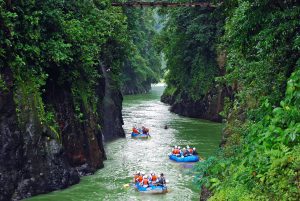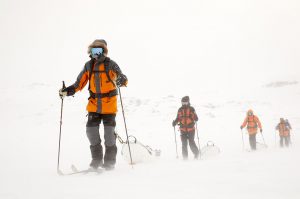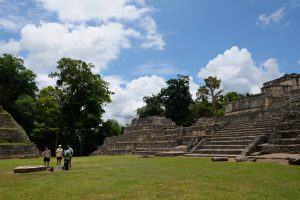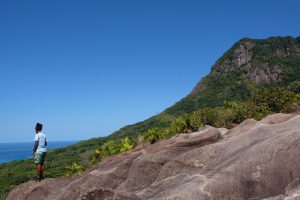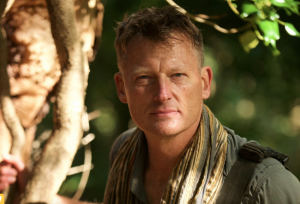
For animal encounters there are few places better than among the birds and the beasts of Botswana’s Okavango Delta, when its floodwater pools are swollen after the rain. Words: Amelia Duggan
View online at natgeotraveller.co.uk
It’s dusk and the wide African sky is an empire of lustrous midnight blue and ash grey clouds. Cumulus castles upon cumulus mountains, altostratus cities beside cirrus rivers. It’s soul-stirringly beautiful.
All along the horizon there’s drama: portals of bright sunlight punch through the cloud canopy, turning the glassy floodwater pools of the Okavango Delta a rich gold; elsewhere, gauzy veils indicate distant rain showers. In the east, Venus is sparkling under a crescent moon so crisp it could have been cut with a Stanley knife. Wildebeest and zebra are grazing all around us in the bush. And against the fading half-light, spindly acacia trees — stripped of bark by hungry elephants — are silhouetted, like delicate ink drawings.
I’m standing shoulder to shoulder with Lena, a burly, middle-aged guide, in awed silence — a gin and tonic, untouched, in my hand, a Coca-Cola, forgotten, in his. It seems, for him, a lifetime in the delta has done nothing to dim its majesty.
Eventually, he breaks the silence with his deep baritone: “That’s why I like the rainy season: no dust. It’s so fresh.” I close my eyes. There’s the coo of frogs; the zither of cicadas; the squawk of a lone bird — Lena, of course, could name the species: these sounds are as familiar to him as the voices of his family. “Right,” he barks, “pula!” He chinks our glasses, downs his in one and nods toward the car. If you’re going to learn one word in Setswana (the local language) it’s pula: it means cheers, it’s the currency, and it’s the word for the all-important, landscape-transforming, life-giving, natural force: rain. There’s a storm coming and it’s time to go.
Driving back to camp, Lena navigates flooded roads, ploughing our jeep through pools so deep the floodwater spills into the vehicle and swirls under my seat (“Feet up!”). When this first happened, I thought we’d go completely under, or get stuck, or that the car would simply pack up, but I quickly learnt to respect the vehicle and Lena’s knowledge of the terrain. Now I love how the jeep splashes into pools like a hippo, creating small waves that push at the tall reeds like fingers combing through long hair.
“The floodwaters came down early this year,” he tells me later, as we eat dinner together. We’re sitting out on the deck of Baines’ Camp, a clutch of luxury huts cantilevered out over a lily-bejewelled Boro River, our four-course meal illuminated by hurricane lamps and the Southern Cross.
“The rains in Angola come down and spread out over 15,000sq km.” He holds his forearm up, spreading his fingers to demonstrate the flow of the water into northern Botswana, the light catching his thick silver wedding band and a number of smooth scars.
Lena comes from the Bayei tribe who were among the first settlers of the delta, and the original craftsmen of the mokoros (canoes) still used for water safaris. His village is today part-owner of the concession operated by Sanctuary Retreats, a 260,000-acre area on the southern edge of the Moremi Game Reserve.
I’m pleased to hear that Baines’ Camp benefits the local community — it was Sanctuary Retreats’ eco-credentials and eagerness to train local staff, Lena says, that convinced the village council to lease this beautiful section of the floodplain to the company.
I enquire about big cats (seeing them in the wild has been a long-held dream of mine). Lena says, “They’ve gone to higher ground on Chief’s Island — maybe you’ll see lions when you go there later on your trip. But it depends — how lucky are you?”
A little deflated, I ask about elephants; we hadn’t come across any on our game drives. Hyenas, buffaloes, giraffes, red lechwes, impalas, mongooses, countless birds, yes — but none of the delta’s wild elephants. “Ah. I think all your elephant questions will be answered tomorrow,” he says, with a knowing wink.
Lightning flashes across the horizon, followed by a booming rumble. “Pula,” he says, raising his glass.

Sanctuary Chief’s Camp, Okavango Delta. Image: Sanctuary Retreats
Party of three
The landscape has taken on fresh shades of green after the night’s rain. Flowers have sprouted overnight: there’s a violet and yellow haze of petals among the reeds. It’s like the vegetation has taken a deep breath.
I’m standing with a dozen travellers in a clearing. It’s unusual to see so many other people out in the bush, away from the camp. Safaris in Botswana’s delta have a privacy and intimacy to them. I’ve not encountered another vehicle on a game drive: the space is just so large, and tourist numbers are carefully regulated. But this morning is an exception: our group is waiting for some special visitors.
I first glimpse them through binoculars: three elephants crossing the waterlogged plain, the first ridden mahout-style by a man and the last seating a woman in the bend of its trunk. It’s an incredible sight.
When they arrive, the khaki-clad woman disentangles herself from her pachyderm ride and strides over to shake our hands. She gives me her business card: Living With Elephants Foundation, Doug and Sandi Groves, CEO. “It also stands for ‘Chief Elephant Officers’,” she says with a grin.
The conservation duo is here to introduce their wards: three orphaned African savannah elephants, rescued from abuse or danger, and brought up together in the delta.
First, there is Jabu, a 11-ft tall, six-tonne bull — and, at the age of 30, he hasn’t even reached his full height yet. We’re invited to place our hands on his trunk and to feel the rough ivory of his tusks. He looks right at me with his dark brown eyes and I notice a white ring around his iris and the tapering of his long lashes. I’d never imagined this detail and complexity in an elephant’s physique. “Go on, feel behind his ears,” Sandi urges. “Ears, Jabu! Ears!” she coaxes. He obediently flaps them open. “There’s a handsome boy!” I reach up and feel the network of thick, warm veins that help cool his blood in the heat of high summer. I’m still resting my hand on his trunk, feeling the movement of muscle and air as he snorts and snuffles, when Sandy tells the group about the price on every elephant’s head.
“There’s a poaching crisis, the likes of which we’ve never seen. We lose around 30,000 African elephants every year.”
I’m shocked to hear that the UK is the second-largest market for ivory, after China. Standing here with Jabu, as his adopted sisters graze peacefully nearby, the full horror of it is brought home.
Botswana is a conservation haven, thankfully, home to some 130,000 of the remaining 300,000 African savannah elephants, many of which have fled poaching in neighbouring states to come to Moremi or Chobe National Park.
After around 20 years with Doug and Sandi, Jabu knows about 100 verbal cues — although, “there’s a lot more he understands informally, too.” Sandy affectionately lists some of the elephants’ traits: Jabu’s confidence, Morula’s sociability, Thembi’s resourcefulness. “We often hear them trumpet softly in their sleep,” Doug adds, leading the other elephants over. “We’ve recorded some rapid eye movement too, so we’re pretty sure they’re dreaming.”
Doug speaks very quietly, but just right for talking to a large mammal with extraordinary hearing. He tells us that his foundation aims to save more elephants from captivity or from hunts, creating a cohesive herd that can be released back into the wild. I can’t image how heartbroken Doug and Sandy will be to see these three go after so many years of living together.
We’re off walking with the elephants now, each taking turns to stride alongside Morula, who follows Sandy obediently, occasionally distracted by some tasty grass.
Ahead of us, a saddle-billed stork takes flight, its legs flopping lazily under big, beating wings, white feathers flared against a pure blue sky. A pair of dragonflies flit past, their mesmerising aerial dance enthralling us for the brief moment we can see them, before they melt into the landscape.
I’m thinking about how gorgeous this all is, how important it is for this to be preserved for future generations, when Morula reaches for my hand with her trunk. It’s the most perfect moment.

An African buffalo. Image: Getty
Fit for a king
It’s my last night in Botswana and I’m sitting under brilliant, star-flecked heavens by the sizzling firepit in Chief’s Camp, another Sanctuary Retreat — this time, in the centre of Moremi, in the wildlife hotspot of Chief’s Island. I have Botswanan songs ringing in my ears and sensational local food in my stomach. I feel as sated and content as the bloated lion we’d discovered, dozing beside the carcass of a greater kudu earlier that day.
It’d been a lucky find: Sky, the driver, had noticed vultures circling and, using them as our beacon, found the king of the jungle (or a king at least). Sky had been jubilant, as if spotting a long-lost friend; he’d not seen this particular male lion for a year. I could see the pupils in the cat’s amber eyes, the tufts on his paws, the cragged outline of battle-scarred ears. We were so close.
A week in the delta felt more like a month. Perhaps it was the long days, rising at dawn and turning in after sundown. But I think, in fact, it was because every minute spent driving through the bush was packed with both suspense and learning.
Having grown up in a city, my bird knowledge stretched little further than pigeon and robin. But within a few days I could point out the iridescent malachite kingfisher; recognise a blacksmith lapwing from its skittish, high-kneed dance; name owls, hornbills, coucals, harlequin-patterned carmine bee-eaters, and, my favourite — the red-billed firefinch.
The next morning, Sky takes me to the nearby airfield, leaning out of the vehicle to inspect the fresh lion tracks imprinted on the sandy road. There’s a lion nearby, a wild tableau to discover and marvel at. But, the propeller of the petrol-blue biplane is whirring: sadly, it’s time to leave.
From up in the clouds, the view is priceless: green on green, with shimmering pools and waterways mirroring the racing clouds. The grassland and reed-filled ponds are scored with animal trails; the thirst lands of the Okavango Delta look like the creased palm of a giant hand. And, just as with wrinkles, I suspect every pathway has a story to tell.
How to do it
Africa Sky offers a six-night package including two nights’ each at Sanctuary Stanley’s Camp, Sanctuary Chief’s Camp and Sanctuary Baines’ Camp from £3,999 per person. The price is based on two adults sharing on an all-inclusive basis throughout, including all game drives and activities; return flights from Heathrow to Maun; and internal flights/transportation. Based on travel in November.
Published in Experiences 2017, free with the Jul/Aug 2017 issue of National Geographic Traveller (UK)



